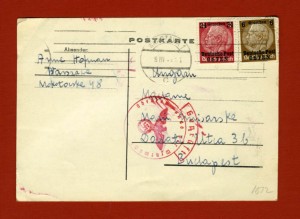 I collected stamps as a boy. Mostly I was imitating my father. He collected only Polish stamps, and his collection begins with the outbreak of the Second World War. The earliest stamp is postmarked “Warszawa 1940.” It is not Polish but German, and bears the stern countenance of Paul von Hindenburg. The stamp is overprinted Osten, meaning East, that is, occupied Poland. My father’s collection includes poignant stamps issued by the provisional Polish government in London, as well as military stamps of the Polish II Corps in Italy, where he served in the SOE. Most of the stamps date from the postwar period and are rather dull in appearance. They portray Polish heroes: Copernicus, Chopin, Madame Curie, and equally predictably, Karl Marx and Stalin, for Poland was then in thrall to Soviet Communism. The album is homemade, the pages, carefully ruled in pencil, have space for every stamp, and include the date of issue, denomination, image, color, and the Stanley Gibbons catalog number. My father was an engineer and he liked everything just so. The entries are in Polish except for the colors which—unaccountably—are in English: “dull purple,” “deep green.” Perhaps it is an early sign of an émigré’s cultural dichotomy. I suppose the collection, which peters out in 1954 shortly after the family emigrated from Britain to Canada, was a way of keeping in touch with the homeland from which he had been rudely separated by the war. Or maybe it was just a way of introducing some small order into a disordered life.
I collected stamps as a boy. Mostly I was imitating my father. He collected only Polish stamps, and his collection begins with the outbreak of the Second World War. The earliest stamp is postmarked “Warszawa 1940.” It is not Polish but German, and bears the stern countenance of Paul von Hindenburg. The stamp is overprinted Osten, meaning East, that is, occupied Poland. My father’s collection includes poignant stamps issued by the provisional Polish government in London, as well as military stamps of the Polish II Corps in Italy, where he served in the SOE. Most of the stamps date from the postwar period and are rather dull in appearance. They portray Polish heroes: Copernicus, Chopin, Madame Curie, and equally predictably, Karl Marx and Stalin, for Poland was then in thrall to Soviet Communism. The album is homemade, the pages, carefully ruled in pencil, have space for every stamp, and include the date of issue, denomination, image, color, and the Stanley Gibbons catalog number. My father was an engineer and he liked everything just so. The entries are in Polish except for the colors which—unaccountably—are in English: “dull purple,” “deep green.” Perhaps it is an early sign of an émigré’s cultural dichotomy. I suppose the collection, which peters out in 1954 shortly after the family emigrated from Britain to Canada, was a way of keeping in touch with the homeland from which he had been rudely separated by the war. Or maybe it was just a way of introducing some small order into a disordered life.


It sounds as if your father was keeping a journal, of sorts, making a “scrapbook” record for himself, with his stamp collection. I can think of many people who’d enjoy seeing it, if ever you decide to make it publicly available.